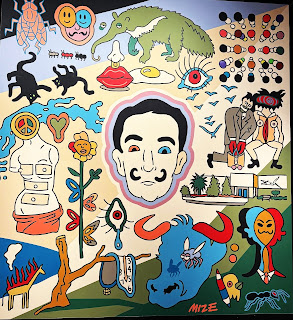For the record, I already had plans to see Bruce Holsinger speak about "Culpability" when the novel was announced as Oprah's July book of the month. (Side note: He was quite funny about getting the call from Orphah, which he thought was a deep fake for the first couple of minutes.) Having read his two previous novels --
"The Gifted School" and
"The Displacements" -- I was interested to hear about his latest offering. As always, it was a treat to hear an author speak about his work.
Like Holsinger's other recent novels, the general theme of "Culpability" is a family dealing with a modern day crisis. In the opening scene, mom, dad and three kids are riding in an autonomous car with Charlie, the 17 year old son, at the wheel. Charlie is "driving" the car hands free as he contemplates his upcoming lacrosse tournament. His sister Alice suddenly cries out from the backseat, "Charlie, stop!" He jerks the wheel with his left hand, a response that sends their car into the other lane and the vehicle of an elderly couple. The couple is killed on contact.
What a start to the story, which gets very complicated very fast. The primary issue is who -- or what -- has legal responsibility for the accident. Charlie seems the obvious choice, since he was the one in the driver's seat. But because Charlie was a minor, the law required a "supervising adult" to be in the front seat with him, a role his father had assumed. Does this make the dad the one at fault for paying insufficient attention? Did Alice and the other backseat passengers play a contributory role? Did the technology have some sort of deficiency? If so, how does that play out? It's a whole new world out there, one our legal system hasn't caught up quite yet.
.jpg) |
| With Bruce Holsinger |
I'm not going to tell you more about the story, which will have your head swimming with all its twists and turns. But I will share one wrinkle with you that the reader learns on the first page of the book. Charlie's mother Lorelei has a dual doctorate in engineering and philosophy, and her work focuses on the ethics of artificial intelligence. She is suddenly smack dab in the middle of a very real world example of the consequences of using AI.
Holsinger shared that he writes the first drafts of his books without thinking too much about themes or even style. His objective is to get the basic story on the page as a starting point. Once he has a draft, he shares it with a group of trusted readers while doing his own review. The most significant change that came out of that process in this case was changing the point of view from which the story was told. Instead of a more objective third person narrative, the story is now told from the perspective of the father.
Holsinger said the book really started coming together once that decision had been made. In addition to the structural shift, he added a new character - a Chatbot that serves as Alice's sounding board and best friend. After her first read of the book, his agent told him, "We need more bot." And so the role of Blair (the ChatBot) grew. It turns out that his agent wasn't Blair's only fan. Oprah told Holsinger that Blair was her favorite character in the book. "That [as a character in the novel] is how I wrote her," he told us. "Correction, that's how I wrote it."
 |
| Poet Jenny Boyar chats with Holsinger |
While to many of us the idea of conversing with a ChatBot might seem odd, "anthropormorphic projection" is a phenomenon most of us engage in every day. To that point (among others), Holsinger shared a passage in the novel from Lorelei's thesis.
"Like our children, our intelligent machines often break rules and disobey commands. The danger comes when we start to assume that such behanvior is intentional, when we regard an algroithm as a willful child. Such habits reflect a common and understandable tendency to humanize Artificial Intelligence. These systems are designed to respond in recognizably human ways. We give them names like Siri and Alexa. We speak to them as if they share our worldview, or care about our feelings and futures. This behavior is known as anthromorphic projections. We want our helpful machines to be like us, and so we tend to project onto them our ways of understanding the world.
Yet such human-seeming systems comprise a small fraction of the AI shaping our everyday experience. Even as you read these words, there are AI systems at work all around you, with profound bearing on the disposition of your food, your money, your shelter, your safety. They manage investment portfolios, coordinate global supply chains and keep networks secure. They direct air traffic, drive trucks and cars, detect fraud...
Increasingly, they fight wars.
And there is almost no one teaching them how to be good."
Yes, there's a reason Oprah selected "Culpability" for her book club. It's not only an interesting story. It's a commentary on the world in which we find ourselves today. I, for one, am not ready. And note to self: Check with my financial advisor as to who's actually managing my portfolio.
Thanks to St. Pete's Tombolo Books for a fun and thought provoking evening. To watch Holsinger's conversation with Oprah, click here. Happy reading!




.jpg)


.jpg)




.jpg)

.jpg)
.jpg)


.jpg)
.jpg)

.jpg)




